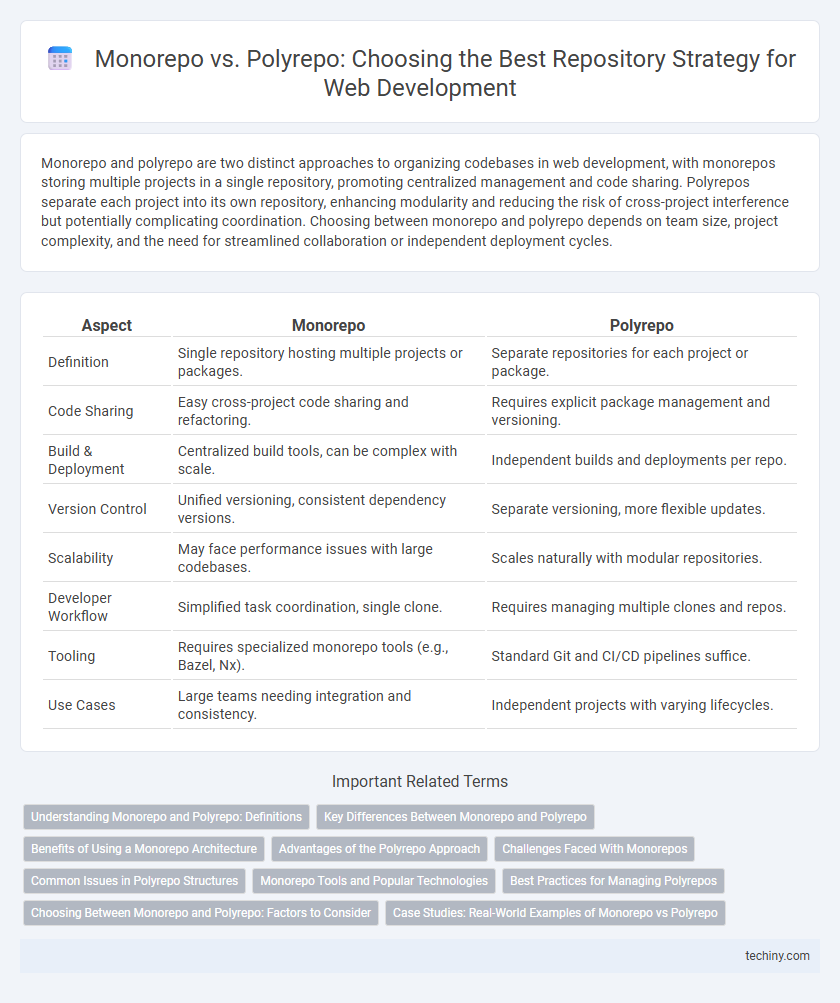Monorepo and polyrepo are two distinct approaches to organizing codebases in web development, with monorepos storing multiple projects in a single repository, promoting centralized management and code sharing. Polyrepos separate each project into its own repository, enhancing modularity and reducing the risk of cross-project interference but potentially complicating coordination. Choosing between monorepo and polyrepo depends on team size, project complexity, and the need for streamlined collaboration or independent deployment cycles.
Table of Comparison
| Aspect | Monorepo | Polyrepo |
|---|---|---|
| Definition | Single repository hosting multiple projects or packages. | Separate repositories for each project or package. |
| Code Sharing | Easy cross-project code sharing and refactoring. | Requires explicit package management and versioning. |
| Build & Deployment | Centralized build tools, can be complex with scale. | Independent builds and deployments per repo. |
| Version Control | Unified versioning, consistent dependency versions. | Separate versioning, more flexible updates. |
| Scalability | May face performance issues with large codebases. | Scales naturally with modular repositories. |
| Developer Workflow | Simplified task coordination, single clone. | Requires managing multiple clones and repos. |
| Tooling | Requires specialized monorepo tools (e.g., Bazel, Nx). | Standard Git and CI/CD pipelines suffice. |
| Use Cases | Large teams needing integration and consistency. | Independent projects with varying lifecycles. |
Understanding Monorepo and Polyrepo: Definitions
Monorepo refers to a single repository that hosts code for multiple projects or components, enabling streamlined dependency management and consistent versioning. Polyrepo consists of multiple distinct repositories where each repository typically contains one project, allowing independent version control and deployment cycles. Understanding these definitions helps developers choose the optimal repository structure for scalability, collaboration, and maintainability in web development.
Key Differences Between Monorepo and Polyrepo
Monorepo consolidates all project codebases into a single repository, simplifying dependency management and enabling atomic commits across multiple projects. Polyrepo separates codebases into individual repositories, promoting autonomy and allowing teams to work independently with tailored workflows. Key differences include scalability, collaboration efficiency, and version control complexity, where monorepos excel in unified visibility and polyrepos offer greater flexibility and isolated changes.
Benefits of Using a Monorepo Architecture
Monorepo architecture provides streamlined collaboration by housing all projects within a single repository, enhancing code reuse and simplifying dependency management. It enables consistent version control and easier refactoring across multiple teams, which speeds up development cycles and reduces integration problems. Centralized CI/CD pipelines in monorepos improve automation efficiency, ensuring faster build times and reliable deployment processes.
Advantages of the Polyrepo Approach
Polyrepo architecture offers enhanced modularity by isolating each project or service in its own repository, simplifying access control and reducing the risk of unintended changes across teams. It promotes independent versioning and deployment, allowing development teams to iterate faster without impacting other parts of the system. The separation also streamlines CI/CD pipelines, improving scalability and customization for diverse project requirements.
Challenges Faced With Monorepos
Monorepos present challenges such as complex dependency management and scalability issues as the codebase grows, leading to longer build and test times. Handling version control conflicts and maintaining consistent tooling across multiple teams can slow development velocity. Debugging and deploying individual services become more difficult due to tight coupling within the single repository structure.
Common Issues in Polyrepo Structures
Polyrepo structures often lead to dependency management challenges, such as version synchronization issues across multiple repositories. Developers frequently encounter difficulties in maintaining consistent build configurations, resulting in increased integration overhead. Additionally, code duplication tends to rise, complicating refactoring efforts and reducing overall development efficiency.
Monorepo Tools and Popular Technologies
Monorepo tools like Bazel, Lerna, and Nx streamline code management by centralizing multiple projects within a single repository, enhancing dependency sharing and consistent versioning. Popular technologies for monorepos include TypeScript, React, and Node.js, which benefit from integrated builds and unified testing processes. These tools improve developer productivity and simplify continuous integration pipelines in large-scale web development environments.
Best Practices for Managing Polyrepos
Effective management of polyrepos involves establishing clear version control practices, consistent naming conventions, and automated dependency updates to maintain synchronization across repositories. Incorporating CI/CD pipelines tailored to each repository ensures quicker feedback and reduces integration issues. Regular communication and documentation are critical to prevent silos and to align development standards across distributed teams.
Choosing Between Monorepo and Polyrepo: Factors to Consider
Choosing between monorepo and polyrepo structures depends on factors such as team size, project complexity, and deployment workflows. Monorepos facilitate easier code sharing and centralized dependency management, benefiting large teams working on interconnected components. Polyrepos offer better isolation and scalability for independent projects, making them suitable for diverse codebases with distinct release cycles.
Case Studies: Real-World Examples of Monorepo vs Polyrepo
Google's monorepo hosts millions of lines of code across thousands of projects, enabling seamless code sharing and streamlined dependency management within a single repository. Facebook uses a similar monorepo approach, facilitating rapid integration and consistent code quality across teams. Conversely, Amazon employs a polyrepo strategy to maintain autonomy and scalability across diverse business units, allowing tailored workflows and independent deployment cycles.
Monorepo vs Polyrepo Infographic

 techiny.com
techiny.com